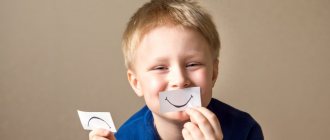Leading activity is a certain direction of activity performed by the child, which determines the most important moments in the formation of the psyche and the development of its processes and characteristics. In leading activity there is a transformation, restructuring of mental processes, methods of previously performed activities, and personality development.
Leading activity is a category in psychology that does not necessarily occupy the main time in a child’s life, but it determines the process of development of the main required qualities and new formations in each period. A change in the emphasis of activity occurs with age, but is not limited by strict boundaries, because focused on a change in motivation, which changes during the activity performed.
Psychological age in relation to this concept is considered in a combination of criteria of the social situation and the needs of basic new formations; the combination of these points takes into account the leading type of activity. Not only the number of days lived by a person, but also the social situation reveals the child’s typical relationships with people, through which one can trace the features of the individual’s personal relationship with reality. The formation of new processes can be accessible to the child only through activities performed that establish contact between him and the elements of reality. In addition to this external property, leading activity rebuilds and forms new processes that are basic for a certain age of the child.
The emergence of a new leading type does not cancel the implementation of important activities at the previous stage; rather, it is similar to the process of transformation and development of previously performed activities to satisfy the new emerging interest.
This is a leading theory in psychology that has many followers and critics. Thus, it is emphasized that despite the fact that the activity performed mediates developmental processes, it is not clearly fixed and defined for age intervals. More than the temporary course of events, the influence is exerted by the level of development and orientation of the social groups in which the child is included. Accordingly, the most relevant activity in the current social situation will become the leading one. This theory is valid only within the framework of child psychology and does not extend to further existence. The concept is not advisable to use to illustrate and study the mechanisms and components of holistic and adequate personality development, but only for one side of it - the development of the cognitive component.
Periodization of leading activities in child development
Periodization and delimitation of leading activities occurs on the basis of age periodization and changes in psychological ages. Each such transformation occurs through the passage of a crisis transformation, where a person can get stuck or go through it quickly. The methods of coping also differ; for some, the change in activity occurs softly and organically, while for others it resembles a local apocalypse. There are different types of turning points: relationship crises (three and twelve years), resulting from changes in social position and interaction, and crises of ideological concepts (one, seven and fifteen years), confronting the individual with a change in his semantic space.
Periods characterized by a certain type of leading activity are divided into:
- Infancy (2 months - 1 year): the leading type of activity is carried out unconsciously, obeying primary instincts, manifests itself in emotional communication with the environment.
— Early age (1 - 3 years) is distinguished by the predominance of object-tool (manipulative) activity that takes on a social context, i.e. implies precisely a social way of mastering a subject. There is a lot of experimentation with the qualities of objects.
- Preschool age (3 - 7 years) - the main activity of the development of mental neoplasms comes down to the study and interiorization of social role-based interpersonal interactions. It is carried out through role-playing games to understand the relationships, tasks, motives of various actions depending on the accepted social role and the object used. Here, norms and rules, peculiarities of culture and society, and the development of the ability to communicate with peers are learned. The formation of this social layer so early makes it difficult to change these parameters in the future.
- Junior school age (7 - 11 years) - the leading activity is educational activity, and any activity that allows one to acquire new knowledge is considered.
- Adolescence (11 - 15 years) - there is a shift in priorities towards intimate and person-oriented communication, and if at the previous stage communication played a functional role for learning, now learning becomes a platform for communication.
— Youth (graduation from school) is characterized by educational and professional activity, where new goals and value systems are established and necessary skills are honed.
The activity of any stage is multifaceted and has a motivational and operational side. One of these components may predominate, since their development is not synchronized, and their tempo characteristics are due precisely to the activity being performed. It is noticed that there is an alternation of activities with a predominance of either a motivational or an operational component. For example, if in infancy the motivational side and the emotional aspect of interaction are maximally involved, then at the next stage operational interaction with the world and its study begins to predominate. Then further change and alternation occurs again. Such alternations are always oriented towards advance, creating with such a gap the conditions for further development. A high level of motivation leads the child to those conditions where he begins to feel a lack of operational skills, and then the next type of activity is turned on. At the stage of complete mastery of the operational aspects of a certain period, a lack of motivation begins to be felt, which does not allow one to remain at the achieved level and, accordingly, a new phase of development begins, with a predominant motivational component. The conflict between motivation for achievement and the level of opportunities present is an internal element of triggering development.
It is important to understand that such a confrontation between the leading components does not mean the presence of only one of them; rather, their influence is inseparable; the focus of attention simply changes from the operational side to the motivational side and back.
Types of actions with objects
The leading type of activity in early childhood is the basis for the intellectual, speech and psychological development of the baby. Two types of actions with objects are of greatest importance: correlative and instrumental.
The goal of the former is to bring objects or their parts into predetermined spatial relationships. The child assembles a nesting doll, selects lids for jars, and puts parts into the holes. In doing so, he must take into account the sizes, shapes or colors of objects. It is impossible to master correlative actions without contact with an adult. The baby independently strings the rings of the pyramid in any order; he has not formed a reference pattern and the need to follow it. Playing together with your mother makes you want to assemble the toy correctly.
Tool actions suggest that the baby learns to handle an object in the way that is accepted in society. He must adapt his movements to the characteristic features of the thing (digging with a shovel, painting with a brush, wiping with a towel). Thus, the leading activity of a young child leads to the formation of elementary logic. Initially, the baby carries the spoon to his mouth along the shortest path, like a cookie or cracker. But over time, he realizes that this is how the soup is spilled. The spoon must be kept horizontal at all times. First, it is lifted up above the plate, and then brought to the lips.
Leading activities at an early age
At an early age, after the motivational component has been saturated with emotional communication, the child’s leading activity is distinguished as object-manipulative. The main task is to learn how to interact with objects of interest, which can happen when repeating the actions of an adult, as well as when inventing new, sometimes original and impractical ways of using them. You may try to collect sand into the bucket not with a spatula, but with a strainer, or comb it with lipstick, etc. Development occurs best if the child masters as many actions as possible that interest him (usually through repeated repetition), and also invents a large number of ways to use the object.
The more simple actions the child practices by repeating after his parents, the more detailed he explores the subject, the better his personal understanding will be formed. The number of subjects should increase after one has been studied completely, i.e. The principle of intensive and deep study of one subject, instead of superficial acquaintance with many things, operates here. Often this comes down to repeating an action a huge number of times, without any final meaning (rolling the machine, wiping all surfaces with a cloth, regardless of dirt, etc.). From the point of view of adults, these repetitions may be meaningless, but they stimulate the child’s thinking and search for new solutions.
Interaction in various ways, rather than theoretical acquaintance with the subject, allows the child to remember it well, form his own idea about it, be able to pronounce its name and many other basic things. If a child is simply shown a new object, called its name and shown how to handle it, then there is no question of remembering the name at all, and the manipulations will be of an educational nature.
Manipulative activity finds its implementation in household chores. By allowing the baby to help in activities such as mopping the floors, watering flowers, cooking dinner, cutting out cookies, etc., parents simultaneously introduce him to all household objects and allow him to learn how to interact with them in an interesting way. In addition, involvement in home activities, as a habitual way of life, will help mitigate the crisis of the third birthday, when the question of one’s place in the world and social importance becomes acute.
The use of special games also helps to develop these functions, but their use should be an auxiliary tool. The development of a child in special, artificial conditions immerses him in a fictional world, and learning to interact with reality does not occur. Such children can be excellent at moving chips, but find themselves absolutely helpless when tying their shoelaces. So, by leaving household chores to the active phase of the child’s day and involving him in the process, parents provide him with more care than by trying to do all the cleaning during the child’s sleep.
An important rule is to accept mistakes and allow your child to make them and learn from them. Let the plate fall while washing the dishes because it is soapy and slippery, let it be the sixth broken plate, but on the seventh he will understand and everything will work out. If parents do not understand the ongoing process, then one may encounter impatience and the child’s withdrawal from the chosen activity. This stops the formation of the skill, the need for development is frustrated, the child’s self-esteem decreases and motivation disappears.
Needs of a baby 1-3 years old
A young child is entirely dependent on an adult. He cannot satisfy his needs on his own. In addition, the baby needs the love and attention of its parents and communication with them. But at the same time, the baby can do a lot himself. He walks confidently and is able to pick up things he couldn’t reach before. He develops a desire for independence.
The contradiction that has arisen is resolved through the leading type of activity at an early age. Briefly, it can be described as the practical joint interaction of a baby and an adult with objects.
Babies begin to explore toys and things at about 6 months. They shake the rattle, knock it, press buttons, feel it with their hands and lick it. These actions are aimed at studying the physical properties of an object. At an early age, the child is more interested in its purpose. However, a baby cannot learn the correct actions with objects without the help of an adult. He does not have enough experience to independently understand the purpose of a pencil, spoon or comb. A leading activity at an early age is the opportunity to partner with mom or dad.
An adult acts as a mentor who shows socially developed methods of action, but does not carry them out for a fee. A situation of business communication is created. The baby, on the one hand, receives the necessary attention, and on the other, learns to act independently.
Leading activities in primary school age
Entering this age is characterized by a change in lifestyle and the development of a fundamentally new activity - educational. A child’s presence at school lays down new theoretical knowledge and forms social status, develops interaction with people, which determines the child’s own place in this hierarchy of interaction. In addition to dramatic changes in conditions and lifestyle, difficulties for the child lie in physiological changes and weakening of the nervous system. In a growing organism, developmental disharmony occurs when rapid physical growth predominates at this stage and most of the body’s resources are spent on this. Problems of the nervous system can manifest as increased excitability, motor activity, anxiety and fatigue. There is an increase in vocabulary, it is possible to invent your own language.
In learning, not only the theoretical knowledge and experience of previous generations is absorbed, but also systems of control, evaluation and discipline. Through educational activities, interaction with society occurs, the child’s basic personal qualities, semantic guidelines, and value preferences are formed.
The acquired knowledge now represents theoretical experience accumulated over generations, rather than direct substantive study of the subject. A child cannot change the use of an object, the course of biological reactions, history, physical processes, but when interacting with knowledge about this, he changes himself. No other activity, except educational activity, puts the person himself as the object of change. This is how the development of internal qualities and processes occurs. At this stage, the cognitive task is still determined by the teacher, and attention is directed. At the next stages, the child learns to independently search for meaning and identify needs.
Educational activity manifests itself as self-changes and the ability to notice these changes. Here reflection begins to develop, an objective assessment of one’s skills and needs, and the correspondence of existing knowledge to the task at hand. The ability to regulate one’s behavior in relation to social norms, and not just one’s own needs, is formed.
Learning occurs in building interpersonal relationships with representatives of various categories. Thus, interactions and friendships with peers are formed not by personal qualities of interest, but by external circumstances. A school friend becomes the one who sits on the next desk or stands nearby during physical education. In addition to equal communication, a style of interaction with adults is formed, which at the moment is also impersonal. The child learns to obey the hierarchy, and the relationship with the teacher is assessed through the prism of academic performance.
Emergence of other activities
Through manipulations with objects, the baby becomes involved in new relationships. The leading activity of a young child creates the prerequisites for the emergence of:
- Labor activity. The baby is interested in using a broom, wiping dust with a rag, watering flowers with a watering can, and making cookies from dough. Not all parents are ready to patiently teach their child these skills. If a child is removed from household chores, his self-esteem decreases and his motivation to work disappears.
- Gaming activity. First, the child manipulates the toys, repeating the movements of the mother: feeding the bear, rocking the doll. He doesn’t depict anything yet, but simply copies. Gradually the imagination develops. By the age of 3, children are able to reproduce the real actions of adults with the help of toys and substitute objects. At the same time, during the game the child comes to an awareness of the role he plays (cook, mother, hairdresser, driver).
- Productive activities (drawing, modeling). Initially, the baby simply explores the material, learns to scribble with a pencil, without trying to depict something meaningful. The turning point comes when he begins to guess real objects behind random shapes and lines. The kid first applies the strokes, and then joyfully looks for what happened. With the participation of an adult, he develops a desire to deliberately depict some light images.








